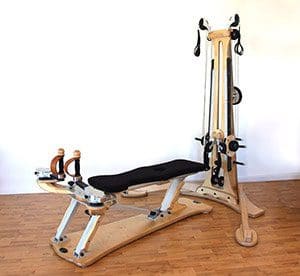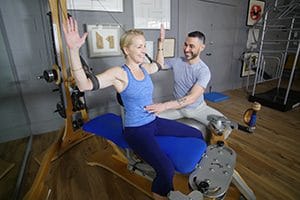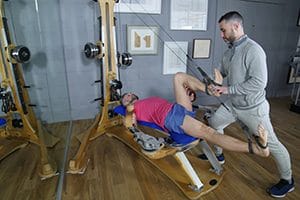Gyrotonic® is a holistic exercise system, and a fantastic way to keep fit, flexible and strong. It consists of circular, spiralling and rhythmical movements that promote deep strength and flexibility. Some of the exercises are very challenging and strengthening but cause surprisingly little stiffness the following day. Pilates and AFS can increase its effectiveness.
Gyrotonic® is performed on specialist equipment, available in our Notting Hill Studio , which has a bench with rotating handles for arm movements and spinal rotation. There is also a reduction pulley system with straps for the hands and feet. These are for larger movements of the spine and limbs.
How Gyrotonic® in Notting Hill Works

Gyrotonic® uses flowing movements that are coordinated with controlled breathing. It differs from Pilates breathing in that it can be through the mouth or nose. Some exercises require a smooth slow breath while others call for a fast percussive breath.
In the first part of a Gyrotonic® class in our Notting Hill Studio the client uses the handle units to learn the basic arch and curl that forms the basis for all Gyrotonic® exercises. The client is taught to sit actively by engaging the centre of the pelvis. The rocking and spiralling movements are initiated in the pelvis and spine. The trunk muscles are engaged and the client is cued to close the ribs to prevent flaring of the ribcage.
One of the reasons this is so important is that our abdominal muscles are attached to our ribs. The closing of the ribs helps the abdominals to work effectively and keeps the centre of the trunk connected and engaged.
These exercises quickly identify any stiffness in the spine or ribcage and immediately help to improve the range of movement, reducing stiffness and giving the client a sense of release.
In daily life our abdominal muscles are stimulated and loaded by rotating the trunk. Movements like walking or running do this. Athletic movements like tennis and golf also do this. If the trunk muscles are to work to their maximum capacity, there must be enough spinal rotation and extension to load them properly.

With longer working hours and increasingly sedentary working lives, our postures are getting worse and our upper back and ribcages are getting stiffer and more prone to aches and pains.
Gyrotonic® in our Notting Hill Studio is the ideal way to restore and maintain these essential lost movements. Many of the arm and leg exercises replicate some of the neural mobilisation treatments used by osteopaths and physiotherapists. This helps to maintain a healthy and flexible body by encouraging the nerves to glide between the muscles with ease.
When performing Gyrotonic® leg exercises, the reduction pulley system makes the legs feel almost weightless. It takes a while to get used to and regain control. The exercises themselves go through a routine of symmetrical, asymmetrical and back to symmetrical movements.
The basic leg exercises usually include bicycling, scissors and leg circles.
Other components include dynamic twisting movements of the spine and abdominal work.
The Origins of Gyrotonic®
Gyrotonic® was created by Juliu Horvath, a Hungarian/Romanian Dancer. It has its roots in kundalini yoga, ballet, gymnastics and Tai Chi. It promotes deep strength, flexibility, coordination and body awareness.
Gyrotonic® is suitable for people of all ages and physical ability.
Juliu opened White Cloud studio in New York in the 1980s. At this time, the hand crafted machines were all made by Juliu himself.

Because of the nature of the system it has always been very closely associated with dance but over the past decades it has found a wider audience.
Some of Germany’s most prestigious clinics use Gyrotonic® as a rehabilitation tool. One surgeon was so intrigued by the results he saw in his patients that he enrolled in a Gyrotonic® teacher-training programme.
The system has been used with great success in older patients to restore much needed movement in the thoracic spine and limbs as well as improving strength. One of the reasons for this success is the gentle nature of the technique. It mobilises and strengthens without feeling harsh or straining the patient.
